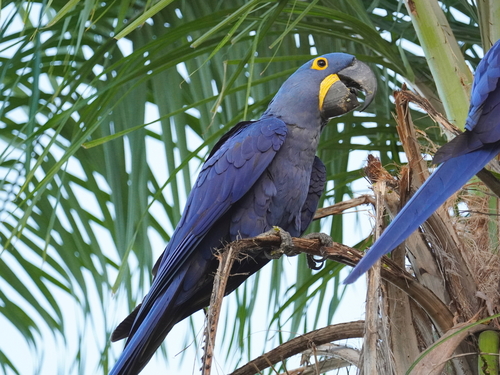
Hyacinth Macaw
The Hyacinth Macaw (*Anodorhynchus hyacinthinus*) is the largest parrot species by length in the world, renowned for its vibrant cobalt-blue plumage, striking yellow eye-ring, and powerful beak. Native to central and eastern South America, this magnificent bird plays a crucial role in its ecosystem, primarily as a seed disperser. It holds cultural significance for some indigenous communities, often featured in folklore and traditional crafts. However, its beauty and size have also made it a target for the illegal pet trade, contributing to its vulnerable conservation status.
95-100 cm
Length
117-127 cm
Wingspan
Vulnerable
Conservation Status
Distribution
The Hyacinth Macaw has three known main populations in South America: in the Pantanal region of Brazil, and adjacent eastern Bolivia and northeastern Paraguay; in the Cerrado region of eastern interior Brazil (Maranhão, Piauí, Bahia, Tocantins, Goiás, Mato Grosso, Mato Grosso do Sul, and Minas Gerais); and in the eastern Amazon Basin of Brazil (Pará, east to Maranhão).
Lifespan
Up to 50 years in the wild; potentially longer in captivity.
Hyacinth Macaw's Habitat
Habitat Types
Palm swamps, Woodlands, Semi-open, lightly forested areas
Climate Zones
Tropical, Subtropical
Adaptations
Their strong beaks are adapted to crack open hard nuts and seeds, particularly those of palm trees. They also have specialized feet for manipulating objects and climbing.
Variations
No subspecies are currently recognized.
Appearance
Breeding Plumage
No significant difference in plumage between breeding and non-breeding seasons.
Seasonal Feather Changes
No significant seasonal variations.
Sex Based Plumage Differences
Minimal; males and females have similar plumage.
Notable Features
Vibrant cobalt-blue plumage., Bright yellow skin around the eyes (eye-ring) and at the base of the lower mandible., Large, powerful black beak., Dark grey legs and feet.
Diet and Feeding
Primary Foods
Palm nuts (especially from *Attalea* and *Acrocomia* palms), Fruits, Seeds, Occasionally snails
Foraging Behavior
Hyacinth Macaws primarily forage in trees, using their strong beaks to crack open hard nuts. They often forage in pairs or small family groups.
Specializations
Their exceptionally strong beak is a key adaptation for accessing the hard kernels of palm nuts, which are a staple food source.
Seasonal Diet Variations
Diet may vary slightly depending on the availability of ripe palm nuts and fruits throughout the year.
Behavior
Social Structure
Hyacinth Macaws are generally found in pairs or small family groups. They may congregate in larger flocks at feeding sites or communal roosts.
Communication
Loud, raucous calls, Screeches, Growls, Visual displays (e.g., raising head feathers)
Migration
Hyacinth Macaws are not considered migratory, but they may make local movements in response to food availability.
Territorial or Group Behaviors
Pairs defend their nesting territories during the breeding season. Outside of breeding, they are generally social.
Conservation
Threats
Habitat loss (due to cattle ranching, agriculture, and logging), Illegal trapping for the pet trade, Hunting (for food and feathers, although less common now)
Protection Programs
CITES Appendix I (prohibits international trade), Habitat conservation and restoration projects (e.g., in the Pantanal), Artificial nest box programs, Community education and awareness campaigns
Local National Laws
Protected under Brazilian law.
Population Trend
Decreasing, although conservation efforts have helped stabilize some populations.
Population Estimates
Estimated at around 6,500 individuals in the wild.
Interesting Facts
They are the largest parrot species by length.
This distinguishes them from all other parrot species worldwide.
Their beaks are strong enough to crack open a coconut.
This incredible strength allows them to access a food source unavailable to many other animals.
They play an important role in seed dispersal.
By consuming and moving seeds, they help maintain the health and diversity of their forest habitats.
Young hyacinth macaws are sometimes preyed upon by birds.
Toucans, hawks, and some jays are known to go after hyacinth macaw eggs.
Hyacinth Macaw's tongues have a bone in them.
This makes their tongues effective tools when tapping into fruits.
Faqs about Hyacinth Macaw
Can Hyacinth Macaws be kept as pets?
While it's technically possible, it's highly discouraged and often illegal. They require specialized care, large enclosures, and a specific diet. Their conservation status also makes owning them ethically questionable.
What is the biggest threat to Hyacinth Macaws?
Habitat loss and illegal trapping for the pet trade are the primary threats.
How can I help Hyacinth Macaw conservation?
Support organizations working to protect their habitat, avoid purchasing illegally traded birds, and raise awareness about their plight.
Are Hyacinth Macaws Intelligent?
Yes, they are very intelligent. Parrots, in general, are considered to be among the most intelligent kinds of birds. They are capable of solving complex problems and are known for their ability to understand and mimic human speech.
How loud are Hyacinth Macaws?
Very loud! Their calls can be heard over long distances, and they are not suitable for environments where noise is a concern. Their vocalizations include a range of screeches, squawks, and growls.
Copyright @ Nature Style Limited. All Rights Reserved.
 English
English